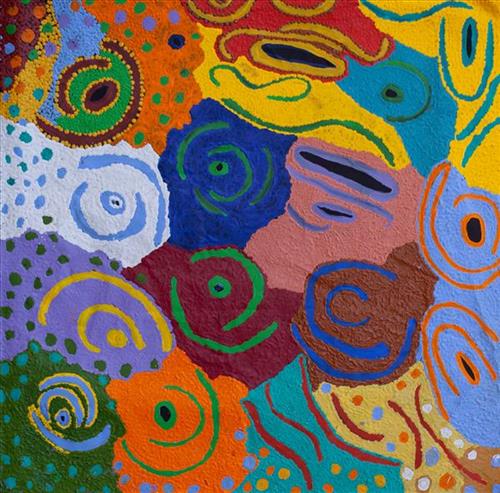Biography:
“We’ve been in Punmu long time. We moved from Camp 61 where we were schooling the kids there. And moved to Punmu, and we stayed there. Big mob of us came back in a truck, in an old tractor with the trailer. That old truck still there at the turnoff. We came in that one now. Me and my partner and my two kids, a boy and a girl. We went there. I had Nyriti [her youngest boy] in Punmu. Right there, next to the school, near the lake. It was good! We started a school there in the bough shed. Before it was in a building. I was there with my two kids. No power or houses. Just a tent. We used to make pujiman (traditional, desert dwelling era) style, with the warta [wood] and leaves, make some shade. Big mob of us there, they all finish now. Jakayu [Biljabu], Minyawe [Miller] there. Then we made the houses.
Good work with the rangers [Kanyirninpa Jukurrpa ranger program]. We see the waterholes, they tell us about our family trees. Go see our Country. Mother’s Country and father’s Country. And now we painting with Martumili. I want to go do painting more. Lovely one, juri [lovely] one. Sit down. I sit down all day, nothing to do at home.”
- Debra Thomas
Debra grew up in Nullagine and went to school both in Nullagine and Jigalong. Later in life she settled at Camp 61, an outstation on Bilanooka Station where she helped set up a community school. Moving to Punmu during the Return to Country movement of the early 1980s, Debra assisted with the establishment of the Punmu School in the Community’s bough shelter.
Over the last several years, Debra has learned to paint by sitting with the older women. She particularly enjoys learning about Country from the senior women and ensuring that her children spend time watching their elders paint and learning the stories for and history of their County. While painting, she talks about the subtle sparkling colours of the plants and flowers that grow around Karlamilyi (Rudall River). In recent years she has also worked as a ranger for the Kanyirninpa Jukurrpa ranger program.
Debra paints her mother's country, which is Warnman country, surrounding Karlamilyi (Rudall River) as well as her father's country, around Kunawarritji.




